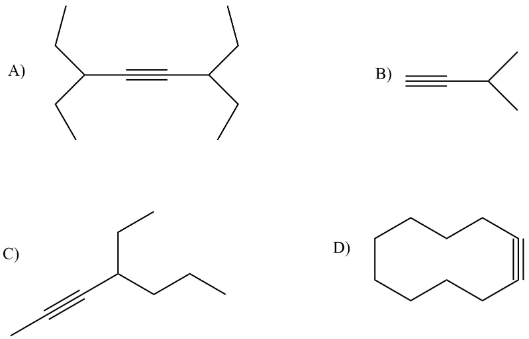The molecular formulas and names of the first ten carbon straight chain alkynes are given below:
Name | Molecular Formula |
Ethyne | C2H2 |
Propyne | C3H4 |
1-Butyne | C4H6 |
1-Pentyne | C5H8 |
1-Hexyne | C6H10 |
1-Heptyne | C7H12 |
1-Octyne | C8H14 |
1-Nonyne | C9H16 |
1-Decyne | C10H18 |
The most commonly used name for ethyne is acetylene, which used mostly used industrially.
Naming Alkynes
As mentioned earlier, the IUPAC rules are used to name alkynes.
Rule 1
Find the longest carbon chain that includes both carbons of the triple bond in the given compound.
Rule 2
Now Numbering of the longest chain starts from the end closer to the triple bond in the compound. A 1-alkyne is referred to as a terminal alkyne, and alkynes at any other position are called internal alkynes.
For example:
Rule 3
Now After numbering the longest chain with the lowest number assigned to the alkyne as a functional group, label each of the substituents at its corresponding carbon. While writing out the name of the molecule, arrange the substituents and extra-functional groups in alphabetical order, and If there are more than one of the same substituent in the compound use the prefixes di, tri, and tetra for two, three, and four substituents respectively. Please note that These prefixes are not taken into account in alphabetical order.
For example:
If there is an alcohol present in the molecule, then number the longest chain starting at the end closest to the alcohol, and follow the same rules. However, the suffix would be –ynol, because the alcohol group takes priority over the triple bond in organic chemistry.
When there are two triple bonds in the molecule, find the longest carbon chain that includes both the triple bonds. Number the longest chain starting at the end closest to the triple bond that appears first in the given compound. The suffix that would be used to name this kind of molecule would be –diyne.
For example:
Rule 4
The Substituents containing a triple bond are called alkynyl.
For example:
Given below is a table with examples of a few of the alkynyl substituents:
Name | Molecule |
Ethynyl | -C≡CH |
2-Propynyl | -CH2C≡CH |
2-Butynyl | -CH3C≡CH2CH3 |
Rule 5
A molecule that contains both double and triple bonds is called an alkenyne. The chain must be numbered starting with the end closest to the functional group that appears first in the given compound.
For example:
If both the functional groups are the exact same distance from the ending of the parent chain, the alkenes takes precedence in the numbering of the compound.
Naming Organic Compounds:
Every day a large number of organic compounds are discovered and most of them are already present on the market, together with the fact that many of these compounds are isomers of other compounds, requires that a systematic nomenclature system be developed to identify them properly. Just as every individual compound has a unique molecular structure and the respective structural formula. As organic chemistry grew and developed over these years, many compounds were given trivial names, which are now commonly used and recognized worldwide. Some examples are:
Methane | Butane | Acetone | Toluene | Acetylene | Ethyl Alcohol |
CH4 | C4H10 | CH3COCH3 | CH3C6H5 | C2H2 | C2H5OH |
Such common names often have their origin in the history of science and the natural sources of a variety of compounds, but the relationship of these names to each other is arbitrary, and no rational or systematic principles or rules underlie their assignments.
The IUPAC Systematic Approach to Nomenclature
A rational nomenclature system must do at least two things. Firstly, It should tell how the carbon atoms of a compound or molecules are together in a lattice of chains and rings. Secondly, it should identify and locate any functional groups present in the given compound. Since hydrogen is such a common component in all kinds of organic compounds, its amount and locations can be assumed from the tetra valency of carbon, and need not be specified in most cases while naming a compound.
The IUPAC nomenclature system is a set of logical rules devised and used by organic chemists to circumvent problems caused by arbitrary nomenclature in naming an organic compound. Knowing these rules and given a structural formula, one should be able to write a unique name for every distinct and different compound. Hence, by providing an IUPAC name, one will be able to write a structural formula of the compound. In general, an IUPAC name will have three essential features in it:
• A root or base indicating a major chain or ring of carbon atoms found in the molecular structure of that compound.
• A suffix that indicates functional groups might be present in the given compound.
• Names of the substituent groups, other than hydrogen, that complete the molecular structure of that compound.
For the IUPAC nomenclature system, consider the compounds that do not have functional groups. Such compounds are composed only of carbon and hydrogen atoms bonded together by sigma bonds in other words all carbons are sp3 hybridized.
1-Octyne
Formula: C8H14
Molecular weight: 110.1968
IUPAC Standard InChI: InChI=1S/C8H14/c1-3-5-7-8-6-4-2/h1H,4-8H2,2H3 Copy
IUPAC Standard InChIKey: UMIPWJGWASORKV-UHFFFAOYSA-N Copy
CAS Registry Number: 629-05-0
Other names: Hexylacetylene; Octyne-1; oct-1-yne
Conclusion
As per the article, how to name the alkynes. We have discussed the formulas of alkynes and its compounds. We have also talked about the IUPAC rules that are used to name alkynes. The IUPAC systematic approach to nomenclature talks about the two things and should follow them. Firstly. It should tell how the carbon atoms of a compound or molecules are together in a lattice of chains and rings. Secondly, it should identify and locate any functional groups present in the given compound.
 Profile
Profile Settings
Settings Refer your friends
Refer your friends Sign out
Sign out




